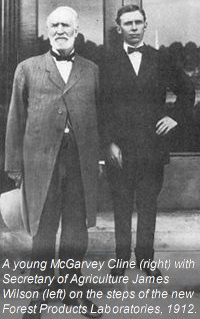 Spruce and Ash
Spruce and Ash
To fly successfully, an aircraft has to be light enough to lift the combined weight of the machine and the people aboard it into the air. And it must be strong enough to support the weight once it's airborne. These two qualities – lightness and strength – are often at odds with one another. Lightweight materials are often weak and strong materials are often heavy.
Fortunately for aircraft builders there are hundreds of wood species, each with different properties that suit them for different types of construction. The Wrights chose to make the straight parts of their airplane (such as the spars and struts) from red spruce (picea rubens), a tree that grew in the high reaches of the Appalachian mountains. The wood from this tree was very light, but extremely strong for its weight. However, it was not a good wood to bend. For the bent parts of their airplane (such as the ribs), the Wrights used white ash (fraxinus Americana). Ash is 50% heavier than spruce, but it’s much easier to bend. More important, it retains most of its strength when bent. Bending makes many woods weaker.
 These
were good choices. Aircraft builders still use spruce and ash, although they now
substitute Sitka spruce for red spruce, which is no longer available. What is
available, however, is a great deal more information about wood properties to
help you make good choices. Just a few years after the Wright brothers began
their experiments, McGarvey Cline, a member of the fledgling US Forest Service,
recognized a need for scientific research to help better define the properties
of different wood species. In 1910, he began the Forest Products Laboratories at
the University of Wisconsin.
These
were good choices. Aircraft builders still use spruce and ash, although they now
substitute Sitka spruce for red spruce, which is no longer available. What is
available, however, is a great deal more information about wood properties to
help you make good choices. Just a few years after the Wright brothers began
their experiments, McGarvey Cline, a member of the fledgling US Forest Service,
recognized a need for scientific research to help better define the properties
of different wood species. In 1910, he began the Forest Products Laboratories at
the University of Wisconsin.
Today, if you want to know the weight of a wood species, you look up its specific gravity. This is a measurement of density, which determines weight. The denser a substance is, the more it weighs. Water is considered to have a specific gravity of 1.00 and the density of everything else is determined in relation to water. Most woods are less dense than water, which is why woods float. A very few woods are denser than water – their specific gravity is more than 1. Amazingly, not every specie of wood floats!
Measuring wood strength is more complex because wood has grain. The wood fibers are all lined up in the same direction, parallel to the length of the tree trunk or the limb from which the wood was cut. Wood is stronger along the grain direction than across it. Compressive strength measures how much weight or force a wood species will resist parallel to the grain direction (like a wooden table leg) while bending strength measures the force it resists perpendicular to the grain (like a shelf). Both are calculated in pounds per square inch (psi) or kilograms per square centimeter (k/cm2).
If you’d like to see the properties of spruce and ash compared with many other woods, click HERE.